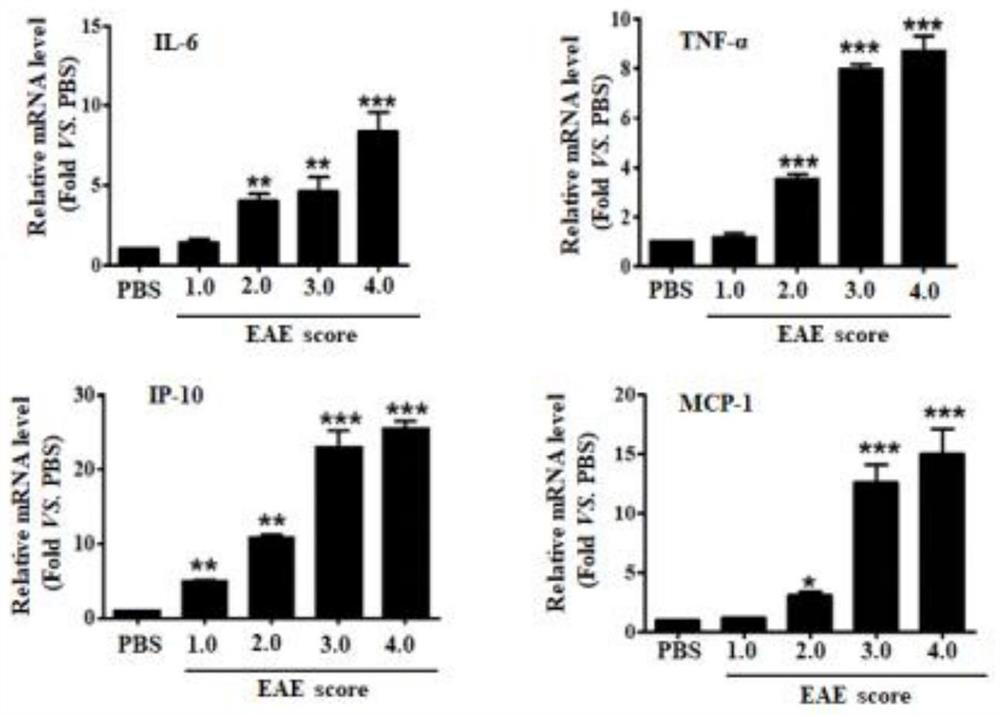LncRNA targeting Notch1 gene and use of LncRNA
A gene-targeted technology, applied in LncRNA and its application fields, can solve problems such as large side effects and ineffective primary progressive MS, and achieve the effects of less toxic side effects, inhibition of central nervous system inflammation and demyelination
- Summary
- Abstract
- Description
- Claims
- Application Information
AI Technical Summary
Problems solved by technology
Method used
Image
Examples
Embodiment 1
[0032] experimental method:
[0033] EAE mouse model induction: 300 μg of myelin oligodendrocyte glycoprotein antigen (Myelinoligodendrocyte glycoprotein amino acids 35–55, MOG 35-55 ) was dissolved in 0.1ml of sterile PBS, 0.5mg of inactivated Mycobacterium tuberculosis was dissolved in 0.1ml of complete Freund's adjuvant, and the two were repeatedly sucked and blown through a three-way tube until a water-in-oil mixture was formed. State, make EAE antigen-induced emulsion, and inject it into mice through subcutaneous multi-point on the back; at the same time, dissolve 200ng pertussis in 0.2ml sterile PBS, on the 0th day and the 2nd day after EAE mouse antigen induction 200 ng of pertussis toxin was injected intraperitoneally. Daily observation, double-blind method for scoring the neurological function of the mice. The criteria are as follows: 0 points, no clinical manifestations; 1 point, decreased tail tone or paralysis of mice; 2 points, partial hindlimb paralysis; 3 poin...
Embodiment 2
[0037] Cultivation of primary cells: take C57BL / 6 suckling mice born within 24 hours, soak them in 75% ethanol for 3-5 minutes under the ultra-clean workbench to disinfect the skin, decapitate, carefully cut the skull with ophthalmic scissors under aseptic conditions, and take On both sides of the brain, the meninges were peeled off under a stereoscope, and the cerebral cortex was taken out and placed in a sterile petri dish filled with pre-cooled D-Hanks solution. Then, rinse twice with pre-cooled D-Hanks solution, cut up the cerebral cortex to make mince, digest with 0.25% trypsin solution at 37°C for 5-10min, and culture completely with DMEM / F12 containing 10% fetal bovine serum The digestion was terminated by pipetting gently, centrifuged at 1200r / min for 5min, washed twice with pre-cooled DMEM / F12 complete medium, filtered with stainless steel mesh (ф=200μm), and transferred to a poly-L-lysine-uncoated Add an appropriate amount of DMEM / F12 complete medium to a glass cultu...
Embodiment 4
[0041] Primary mouse astrocytes were incubated overnight in serum-free medium, then stimulated with IL-9, and total cellular RNA was collected at different time points. Real-time PCR detection of Gm13568 and Notch1 levels in astrocytes, see the results Figure 8 .
[0042] Figure 8 The expression levels of Gm13568 and Notch1 in astrocytes after IL-9 stimulation at different times, it can be seen that the expression levels of Gm13568 and Notch1 mRNA increase or decrease synchronously, and the changes are consistent, which indicates that Gm13568 may be a positive regulator of Notch1 .
[0043] The sequence of Gm13568 was amplified and cloned into a lentiviral transfer vector carrying the GFAP promoter of astrocytes, named LV-Gm13568. Since the sequence of Gm13568 was completely complementary to the sense strand at the 9075-9497 site of the Notch1 gene, we adopted The method of expressing the sequence of its binding region with Notch1 uses competitive inhibition to down-regul...
PUM
 Login to View More
Login to View More Abstract
Description
Claims
Application Information
 Login to View More
Login to View More - R&D
- Intellectual Property
- Life Sciences
- Materials
- Tech Scout
- Unparalleled Data Quality
- Higher Quality Content
- 60% Fewer Hallucinations
Browse by: Latest US Patents, China's latest patents, Technical Efficacy Thesaurus, Application Domain, Technology Topic, Popular Technical Reports.
© 2025 PatSnap. All rights reserved.Legal|Privacy policy|Modern Slavery Act Transparency Statement|Sitemap|About US| Contact US: help@patsnap.com



